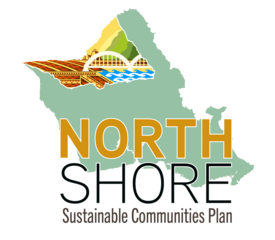Do you agree with the following vision element?
"Maintain the Community Growth Boundary to Protect Agricultural, Open Space, and Natural Resources"
View the 2011 NSSCP description of this vision element below:
The North Shore is characterized by vast tracts of agricultural lands, open spaces, and natural and cultural resources. To protect these resources from development, the Community Growth Boundary was established to guide development and preserve open space and agricultural areas. It has remained fixed since it was first established in 2000, and no new development has occurred outside the Community Growth Boundary. The Community Growth Boundary has served as a valuable tool to guide resource management, future development or redevelopment within existing zoning designations or future zoning designations, and other standards or guidelines that have been developed in response to plan provisions, other established entitlements, or in accordance with pertinent policy and character described in this plan.
The Community Growth Boundary defines, protects, and contains communities in areas which the General Plan designates “rural” and which exhibit the physical characteristics of rural lifestyles. The boundary provides adequate lands for facilities needed to support established communities, and protects such communities from more intense land uses and patterns of development associated with more urban areas. The Community Growth Boundary also preserves areas outside the boundary for agriculture or other resource or open space values. Where appropriate, the area within this boundary also contains open space elements considered essential to the character of the rural community being defined. Open space elements within the Community Growth Boundary may include lands designated “Park,” “Agriculture,” “Preservation,” or areas with development-related hazards such as steep slopes or unstable soils.
Rural communities defined by this boundary consist of residential communities and towns that are smaller, more dispersed, and less intensively developed than those in O‘ahu’s urban or urban fringe areas. Development character is generally low density, low rise, small scale, and reflective of a “country” setting. Within residential areas, the landscaping and front yards which provide the foregrounds to their respective residences are the principal visual elements. In commercial areas, the pedestrian environment and associated amenities predominate, and storefronts are typically found on both sides of the street. Commercial buildings are oriented principally toward the street, relate readily to the human scale, and are organized to encourage interaction between the public and private domains.
As shown on Exhibit 2.1, the Community Growth Boundary on the North Shore conceptually defines the limits of residential, commercial, industrial, or other similar uses. As no proposals for these types of uses can be considered outside the Community Growth Boundary, this boundary also prevents the encroachment of development onto agricultural lands and open space resources. Areas outside the Community Growth Boundary include agricultural lands as well as preservation lands with important open space, scenic, or natural resource values. Uses such as commercial and industrial development, public and private schools, and residential subdivisions with no bona fide agricultural activities are not permitted in these areas. Permissible land uses outside the Community Growth Boundary include agriculture and limited low-intensity types of outdoor recreational uses where appropriate, such as on nonagricultural lands or agricultural lands that are not suitable for intensive cultivation, provided they do not diminish the agricultural potential of these sites or jeopardize the open space, natural and scenic character of these resources. Other permitted uses outside the Community Growth Boundary include environmental and educational programs and facilities that are resource compatible, such as a high technology learning center that uses existing facilities at Camp Mokulē‘ia and Camp Erdman in Mokulē‘ia.
Rural communities within the Community Growth Boundary include concentrations of residential, commercial, and industrial uses as well as the network of roads, parks, and open spaces which define their edges or give them character. Relative to the State Land Use District boundaries, the Community Growth Boundary generally circumscribes built-up sections of Mokulē‘ia, Waialua, Hale‘iwa, Kawailoa, and Sunset Beach that are within the State Urban District. It also includes portions of the State Agricultural District in Sunset Hills and Pūpūkea that are zoned Country, as well as portions of the State Agricultural District makai of the highway in Hale‘iwa and Waialua that are designated and zoned for agricultural use. However, except for limited “infill” areas in Hale‘iwa and Waialua Towns that are contiguous to lands designated for residential and commercial use, agricultural lands within the Community Growth Boundary continue to remain in the State Agricultural District and continue to be designated and zoned as Agriculture, so as to maintain the agricultural uses and/or open space value within the Community Growth Boundary.
Within this boundary, open space continues to define communities, and significant natural resources (such as streams, natural drainageways, wetlands, and fishponds) are protected. New development within the Community Growth Boundary has been limited to infill low-density, low-rise development contiguous to existing built areas, to promote a compact form of development with lower development costs and more efficient utilization of existing infrastructure systems. The infill areas within the Community Growth Boundary have had ample capacity to accommodate residential, commercial, and industrial needs to the year 2035.
